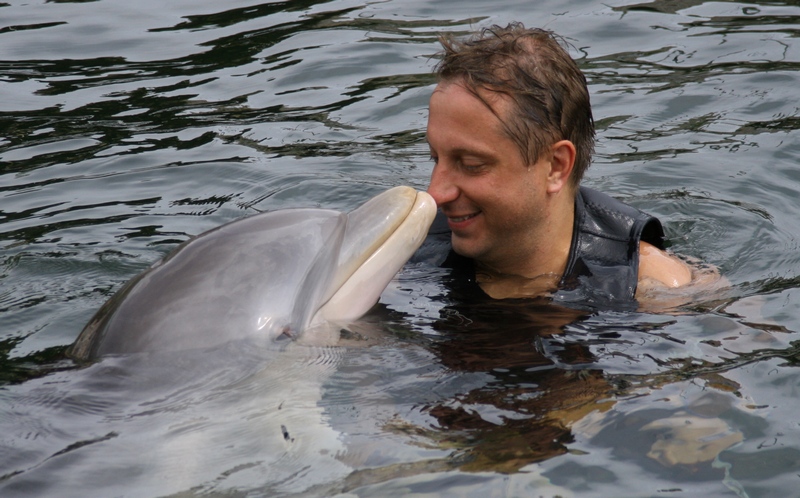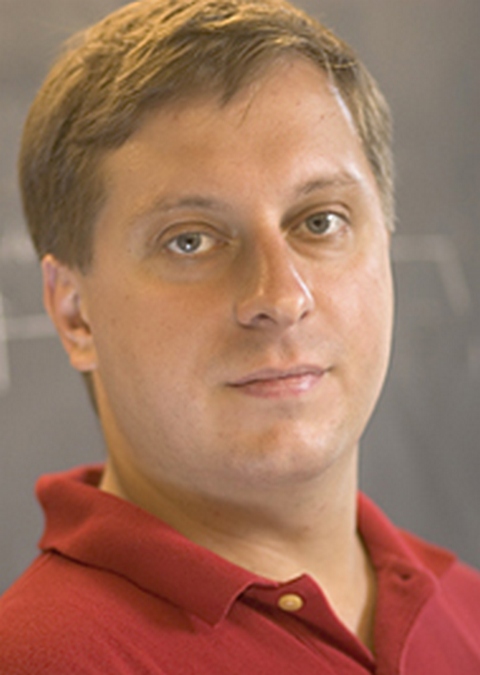|
Congratulations to professor Marin Soljačić, as well as to his parents in Zagreb
 Marin Soljačić, full professor of physics at MIT at the age of 37, swiming with a dolphin in Florida. Photo by the courtesy of his father professor Ivo Soljačić, Zagreb, via Snježana Božić.  Professor Marin Soljačić
Professor Marin Soljačić
Area of Physics:
Condensed Matter Theory
Research Interests
Technological advances of the past decade have enabled the control of the material structure at length-scales smaller than the wavelength of light. This enabled the creation of new materials, e.g., photonic bandgap crystals, or various surface plasmon systems, whose optical properties are dramatically different than those of any naturally occurring material. For example, nanostructured materials which display diffraction-less propagation of light, exhibit negative refraction, or support very slow propagation of light, have all been demonstrated. Professor Soljacic's interests are in exploring the new and exciting physical phenomena supported by these materials.
The unique properties of these new materials have already enabled a wide range of very important applications, e.g., in medicine, telecommunications, defense, etc., and are expected to do so even more in the future. Professor Soljačić is also interested in various topics in nonlinear optical physics. Maxwell's equations as presented in most undergraduate text books are linear. However, all materials in nature are nonlinear (including vacuum), and sure enough, at high light intensities, optical phenomena become nonlinear, displaying a wide range of rich and beautiful behavior. For example, almost every general non-linear dynamics phenomenon, e.g., solitons, pattern formation, fractals, etc., can now be studied in optical material systems. More recently, Prof. Soljačić also became interested in investigating the feasibility of wireless power transfer, which he and colleagues have dubbed "WiTricity."
Biographical Sketch
Marin Soljačić has been an Assistant Professor of Physics since September 2005. He received a BsE degree in physics and electrical engineering from MIT in 1996, and earned his PhD in physics at Princeton University in 2000. In September 2000, he was named an MIT Pappalardo Fellow in Physics, and in 2003 was appointed a Principal Research Scientist in the Research Laboratory of Electronics at MIT. He is the recipient of the Adolph Lomb medal from the Optical Society of America (2005). He was promoted to Full Professor in July 2011.
Selected Publications
- "Coherent optical photons from shock waves in crystals," Evan Reed, Marin Soljačić, Richard Gee, and J.D.Joannopoulos. Phys. Rev. Lett., 96, 013904 (2006).
- "Surface-Plasmon-assisted guiding of broadband slow and subwavelength light in air," Aristeidis Karalis, E.Lidorikis, Mihai Ibanescu, J.D.Joannopoulos, and Marin Soljačić. Phys. Rev. Lett. 95, 063901 (2005).
- “Enhancement of non-linear effects using photonic crystals,” Marin Soljačić, and J.D. Joannopoulos. Invited review article in Nature Materials, 3, p.211 (2004).
- "Collisions of two solitons in an arbitrary number of coupled nonlinear Schrodinger equations," Marin Soljačić, Ken Steiglitz, Suzanne M. Sears, Mordechai Segev, Mariusz H. Jakubowski, and Richard Squier. Phys. Rev. Lett., 90, 254102 (2003).
- "Color of shock waves in photonic crystals," Evan Reed, Marin Soljačić, and J.D.Joannopoulos. Phys. Rev. Lett. 90, 203904 (2003).
- "Pattern formation in a cavity longer than the coherence length of the light in it," Tal Carmon, Marin Soljačić, and Mordechai Segev. Phys. Rev. Lett. 89, 183902 (2002).
Source web.mit.edu
|
MARIN SOLJAČIĆ
DATE AND PLACE OF BIRTH 7th February 1974; Zagreb, Croatia
POSITIONS
Professor; Physics Department, MIT, (2011-
Associate Professor; Physics Department, MIT, (2010-2011)
Correspondent Member; Croatian Academy of Engineering, (2009-
MacArthur Fellow, (2008-
Assistant Professor; Physics Department, MIT, (2005-2010)
Principal Research Scientist; Research Laboratory of Electronics, MIT, (2003-2005)
Pappalardo Fellow; Physics Department, MIT, (2000-2003)
SELECTED AWARDS
Young Global Leader (YGL) of the World Economic Forum: 2011.
MacArthur Fellowship Award: 2008.
SciAm50 Award of Scientific American for outstanding technological leadership (2007).
TR35 Award of the Technology Review: one of top 35 innovators under the age of 35. (2006)
Adolph Lomb Medal of the Optical Society of America for 2005.
EDUCATION
Princeton University, PhD in physics, (1996-2000):
- PhD thesis topic in Non-linear Optics with Prof. Mordechai Segev: "Instabilities in non-linear wave systems in optics"
(academic year 1999/2000 I spent at Technion, Haifa, Israel)
- MA thesis topic in Spin Glasses with Prof. Frank Wilczek: "A simple potential whose number of minima grows exponentially in the number of variables"
MIT, undergraduate education, (1992-1996):
- BSE in Physics
- BSE in Electrical Engineering
- Undergraduate thesis topic in Inflationary Cosmology with Prof. Lisa Randall, and Prof. Alan Guth: "Supernatural Inflation: Inflation from Supersymmetry with No (Very) Small Parameters"
High-school: MIOC, (Zagreb, Croatia) (1988-1992)
Source www.mit.edu
|
Davide Castelvecchi from American Institute of Physics
WIRELESS ENERGY TRANSFER CAN POTENTIALLY RECHARGE LAPTOPS,
CELL PHONES WITHOUT CORDS
Embargoed advance information for November 14, 2006 3:20 pm Pacific Standard Time College Park, MD (November 6, 2006)--Recharging your laptop computer -- and also your cell phone and a variety of other gadgets -- might one day be doable the same convenient way many people now surf the Web: wirelessly. Marin Soljačić of the Massachusetts Institute of Technology will present research by himself and his colleagues Aristeidis Karalis and John Joannopoulos on the physics of electromagnetic fields, showing how wireless energy could power future gadgets. The MIT team is also working on demonstrating the technology in practice. The work will be described on Tuesday, November 14 in San Francisco, at the American Institute of Physics Industrial Physics Forum, which will be co-located with the AVS 53rd International Symposium & Exhibition at the Moscone Center in San Francisco.
Like many of us, Soljačić (pronounced Soul-ya-CHEECH) keeps forgetting to recharge his cell phone, and when the thing is about to die it starts to complain with an unpleasant noise. "Needless to say, this always happens in the middle of the night," he said. "So, one night, at 3 a.m., it occurred to me: Wouldn't it be great if this thing charged itself?" The experience got the MIT scientist thinking hard to see if any of the physics principles he knew of could turn into new ways of transmitting energy.
After all, scientists and engineers have known for nearly two centuries that transferring electric power does not require wires to be in physical contact all the way. Electric motors and power transformers contain coils that transmit energy to each other by the phenomenon of electromagnetic induction. A current running in an emitting coil induces another current in a receiving coil; the two coils are in close proximity, but they do not touch.
Later, scientists discovered electromagnetic radiation in the form of radio waves, and they showed that another form of it - light - is how we get energy from the sun. But turning light into electrical power is notoriously difficult, and requires a direct line-ofsight between transmitter and receiver. Radio waves, and especially microwaves, can be used to transfer energy, which can then be picked up with an antenna. But transferring energy from one point to another through ordinary electromagnetic radiation is typically very inefficient, and can even be dangerous: The waves tend to spread in all direction, so most of the energy is lost to the environment.
However, Soljačić realized that the close-range induction taking place inside a transformer -- or something similar to it -- could potentially transfer energy over longer distances, say, from one end of a room to the other. Instead of irradiating the environment with electromagnetic waves, a power transmitter would fill the space around it with a "non-radiative" electromagnetic field. Energy would only be picked up by gadgets specially designed to "resonate" with the field. Most of the energy not picked up by a receiver would be reabsorbed by the emitter.
In his talk at the AVS meeting, Soljačić will explain the physics of non-radiative energy transfer and the possible design of wireless-power systems.
While rooted in well-known laws of physics, non-radiative energy transfer is a novel application no one seems to have pursued before. And figuring the details was not easy, Soljačić said, something he and his colleagues did through theoretical calculations and computer simulations. "It certainly was not clear or obvious to us in the beginning how well it could actually work, given the constraints of available materials, extraneous environmental objects, and so on. It was even less clear to us which designs would work best."
With the proposed designs, non-radiative wireless power would have limited range, and the range would be shorter for smaller-size receivers. But the team calculates that an object the size of a laptop could be recharged within a few meters of the power source. Placing one source in each room could provide coverage throughout your home. Soljačić is looking forward to a future when laptops and cell phones might never need any wires at all. Wireless, he said, could also power other household gadgets that are now becoming more common. "At home, I have one of those robotic vacuum cleaners that clean your floors automatically," he said, "it does a fantastic job but, after it cleans one or two rooms, the battery dies." In addition to consumer electronics, wireless energy could find industrial applications, for example powering freely-roaming robots within a factory pavilion.
Paper: "Wireless Non-Radiative Energy Transfer," to be presented at the 2006 AIP Industrial Physics Forum, Tuesday, November 14, 2006, San Francisco, CA, Moscone Center, Abstract at http://www.aip.org/ca/2006/soljacic.html
Headquartered in College Park, MD, the American Institute of Physics (AIP) is an organization hartered for the purpose of promoting the advancement and diffusion of the knowledge of physics and its application to human welfare.
Contact: Marin Soljacic
Massachusetts Institute of Technology
Tel: 617-253-2467
soljacic@MIT.EDU
Davide Castelvecchi
American Institute of Physics
dcastelv@aip.org
Source [PDF]
|
Wireless Energy Transfer
"Recharging, The Wireless Way," Angela Chang, abcnews.go.com, 22nd December (2006).
"In the future, will our TVs be wireless?" Athima Chansanchai, www.msnbc.msn.com, 14th December (2006).
"Physics promises wireless power," J. Fildes, news.bbc.co.uk (featured on the front page of BBC News), 15th November (2006).
"Cut the cables - Wireless power," The Economist, p. 85, 18th November (2006).
"Wireless Energy Transfer May Power Devices at a Distance," J.R.Minkel, scientificamerican.com, 14th November (2006).
"Man tries wirelessly boosting batteries," Seth Borenstein, Associated Press, 15th November (2006).
"Evanescent coupling' could power gadgets wirelessly," Celeste Biever, NewScientist.com, 15th November (2006).
"Outlets are out," Phil Berardelli, sciencenow.sciencemag.org (daily news of Science Magazine), 14th November (2006).
Additional media coverage of our work on Wireless Energy Transfer include: BBC Radio 4, BBC World Radio, Forbes, The Boston Globe, Chicago Tribune, Christian Science Monitor, The Herald (UK), PC World, USA Today, FOX news, CBS news, ABC local TV, Physics Today, and more than 300 articles in leading newspapers and radio-reports in numerous countries around the world, including: Germany, Australia, Iran, India, Croatia, Greece, Spain, France, Italy, UK, Poland, Canada, Netherlands, Tailand, Dominican Republic.
Source www.mit.edu
|
The father of Marin Soljačić is Ivo Soljačić, retired professor of chemistry at the University of Zagreb. He was a dean of the Faculty of Technology and the Faculty of Textile Technology in Zagreb. Since 2011 he is the president of the Croatian Catholic Society of Schoolteachers.
Professors Ivo and Marin Soljačić, father and son, are among 500 Croatian scholars and intellectuals who signed an appeal to rename the "Square of Marshal Tito" to "The Square of the Republic of Croatia".
|
Formated for CROWN by prof.dr. Darko Žubrinić
Distributed by www.Croatia.org . This message is intended for Croatian Associations/Institutions and their Friends in Croatia and in the World. The opinions/articles expressed on this list do not reflect personal opinions of the moderator. If the reader of this message is not the intended recipient, please delete or destroy all copies of this communication and please, let us know!
|